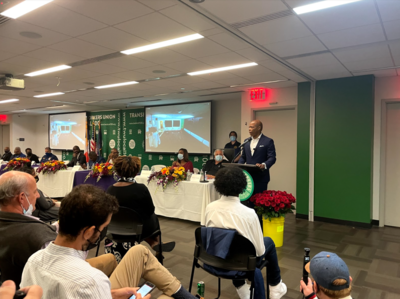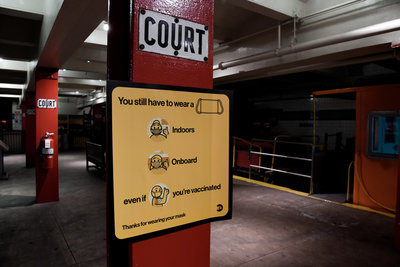‘Believe the Hype’ Column: Casual Encounters in City Life
The following piece was originally printed in our Jan. 11, 2024 edition.
This week, our new Brooklyn community editor, Christine Stoddard, returns with her column “Believe the Hype.” Send your comments, questions, and tips to brooklyndtstarnews@gmail.com.
On this page, you will find a photo of my former neighbor Christina, dated from 2018. I use the term “neighbor” loosely. Christina lived a few blocks away from me when I called Howard Avenue, just south of Atlantic, my home. At the time, I was walking through Bedford-Stuyvesant, Crown Heights, and Brownsville to take posed portraits of people I encountered. The cityscape served as our set. We always exchanged a few words, sometimes going into longer conversations if it flowed naturally. I was curious about folks’ experiences and how we co-existed in Central and East Brooklyn, despite living totally separate lives. Every apartment building or brownstone is a microcosm; bodegas occupy parallel universes. A city park contains galaxies upon galaxies.

A photo the columnist took in 2018 of a neighbor.
Resumed Mask Mandate at NYC Public Hospitals
Though the COVID pandemic has ended, the coronavirus remains with us. As of Jan. 3rd, the mask mandate has resumed at all 11 of New York City’s public hospitals due to a rise in not only COVID but flu and respiratory syncytial (RSV) cases. The mandate applies to NYC Health + Hospitals’ health clinics and nursing homes, too. A COVID surge may inspire any number of reactions: ambivalence, disbelief, fear, frustration, sadness. When I first learned about the reinstated mask mandate, I mentally transported myself to March 2020, back to that apartment on Howard Avenue, and that crippling feeling of isolation. Even next door neighbors were suddenly off-limits. I had to abandon my neighborhood photo project, or at least put it on hold.
Eventually, as we all know, the city reopened, but, as we also all know, it is not the same city we knew in 2019 or even early 2020. What I miss most are the abundance of casual, sometimes heart-warming, hilarious, or incredible encounters that can only happen in a big city like ours. In suburbs and rural areas, people are simply too spread out from one another. There is far less foot traffic (or perhaps none at all). Have you ever been to a small town with no sidewalks? Having lived in different parts of Virginia and Iowa, I have…and it is creepy.
Outside of a metropolis, stand-alone houses and cars silo neighbors from one another. You may have a bigger lawn, but it is unlikely you will meet interesting strangers on the bus or witness unexpected acts of kindness from someone you just met.
Vendor Ban on Brooklyn Bridge
New Yorkers’ appreciation for synchronicity is probably one of the reasons so many people are upset about the vendor ban at the Brooklyn Bridge. The city ban went into effect on Jan. 2, with the Department of Transportation employees and NYPD officers clearing tables and carts at the stroke of midnight. No more souvenir tables. No more pop-up photo booths. No more kebabs. According to Mayor Adams, this ban is necessary for improving pedestrian traffic and safety. Last fall, more than 34,000 pedestrians visited the bridge on an average weekend.
Not everyone agrees that the vendors should go. Currently, New York City Council member Gale Brewer (District 6, Manhattan) is working on legislation to create a designated space for vendors. I, for one, am intrigued by this possibility and hope for a solution that promotes street life without allowing a circus to take hold.
Abolitionist Plaza
While there’s debate on how we ought to use our public spaces, one thing is certain here in Brooklyn: We have them–and, according to the Downtown Brooklyn Partnership’s 2023 Year-in-Review report, there are more on the way. In July, the mayor announced that more than $40 million would be invested in Downtown Brooklyn for streetscape improvements, public space and transportation upgrades, and pedestrian safety enhancements. That includes $8 million in dedicated funding for the Fulton Mall Streetscape.
Also mentioned in the Downtown Brooklyn Partnership report was Abolitionist Plaza, which I am waiting for with bated breath. Slated to open in Spring 2024, the 1.15 acre space between Duffield Street and Albee Square West promises “a children’s play area, waterplay feature, lawn space, a dog run, multiple seating areas, and more.” It’s hard not to raise an eyebrow at “and more,” but let’s check it a few months (fingers crossed) to see what we find. Or at least I will!








